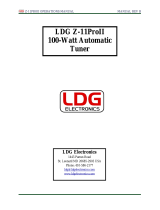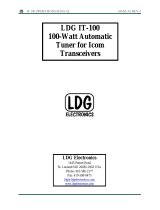Page is loading ...

LDG Balun and Unun
User’s Manual
Introduction
Congratulations on your purchase of an LDG Balun or Unun. These quality units greatly expand
the utility of your LDG Automatic Tuner, allowing much greater flexibility in the type of antenna
and transmission line you can use. LDG’s Baluns and Ununs are inspired by the designs of Jerry
Sevick, W2FMI (SK) in his classic book Transmission Line Transformers.
All LDG Baluns and Ununs are rated at 200 watts PEP, and are water resistant; they are intended
for outdoor use. Each weighs 6 oz, and measure 5”x2.5”x1.2”.
Baluns and Ununs
Balanced antennas are electrically symmetrical and do not rely on connection to the ground; an
ordinary dipole is a good example of a balanced antenna. Unbalanced antennas are asymmetrical
and rely on a ground, such as a ¼ wave vertical antenna operated against a ground plane. All
modern radios have unbalanced outputs, and all coaxial cable is unbalanced.
Feeding a balanced antenna with an unbalanced transmission line can lead to unwanted RF
current distribution that degrades performance. Baluns are circuits that match an unbalanced
transmission line to a balanced load, and can adjust the impedance ratio as needed. Ununs match
unbalanced transmission lines to unbalanced loads, also adjusting impedance.
RU-9:1
The RU-9:1 is a 9:1 Unun that allows you to easily match an end-fed long
wire antenna with your LDG Automatic Antenna Tuner. Connection is
made by a 5-way, twist-on binding post; connect the red post to the
antenna. A ground terminal connection is available for an optional
counterpoise or radial system. The RU-9:1 is intended to match a long wire
antenna of 30-135’, with or without a ground.
RU-1:1
The RU-1:1 is a 1:1 Unun intended to help remove unwanted RF from the
coax cable shield. It is normally used as a common-mode RF choke for short
coax cable runs or non-resonant antennas. The RU-1:1 features SO-239
sockets for both input and output.

RBA-1:1
The RBA-1:1 is a 1:1 Balun designed to allow easy interface to Dipoles,
Inverted Vees and other center insulated wire antennas. The Balun can
operate “stand alone”, or it can be used with an LDG Automatic Tuner. It
may be used with any of your long, random, ladder line or balanced
antenna projects. Connection is made by 5-way, twist-on binding posts.
RBA-4:1
The RBA-4:1 is a 4:1 Balun that allows your LDG Automatic Antenna Tuner
to easily match an antenna fed with Twin-lead or Ladder-line. The Balun
can also operates “stand alone” without a Tuner. It may be used with any
twin-lead or ladder-line antenna projects. Connection is made by 5-way,
twist-on binding posts.
RU-4:1
The RU-4:1 is a 4:1 Unun designed to allow your LDG Automatic Antenna
Tuner to easily match vertical and end-fed antennas. It can also operate
“stand alone”, and may not require an LDG Tuner for resonant verticals. It
may also be used with any antenna project where a 4:1 Unun is needed.
Connection is by 5-way, twist-on binding posts; connect the red post to the
antenna.
Warranty
All LDG Baluns and Ununs are warranted for two years against defects in parts or workmanship.
This warranty is fully transferable; if you sell or give away your product, simply give the new
owner the receipt, and the remainder of the warranty goes with it. If service is required, refer to
LDG’s web page for information on how to request warranty service.
Visit us on the web at www.ldgelectronics.com
/


















